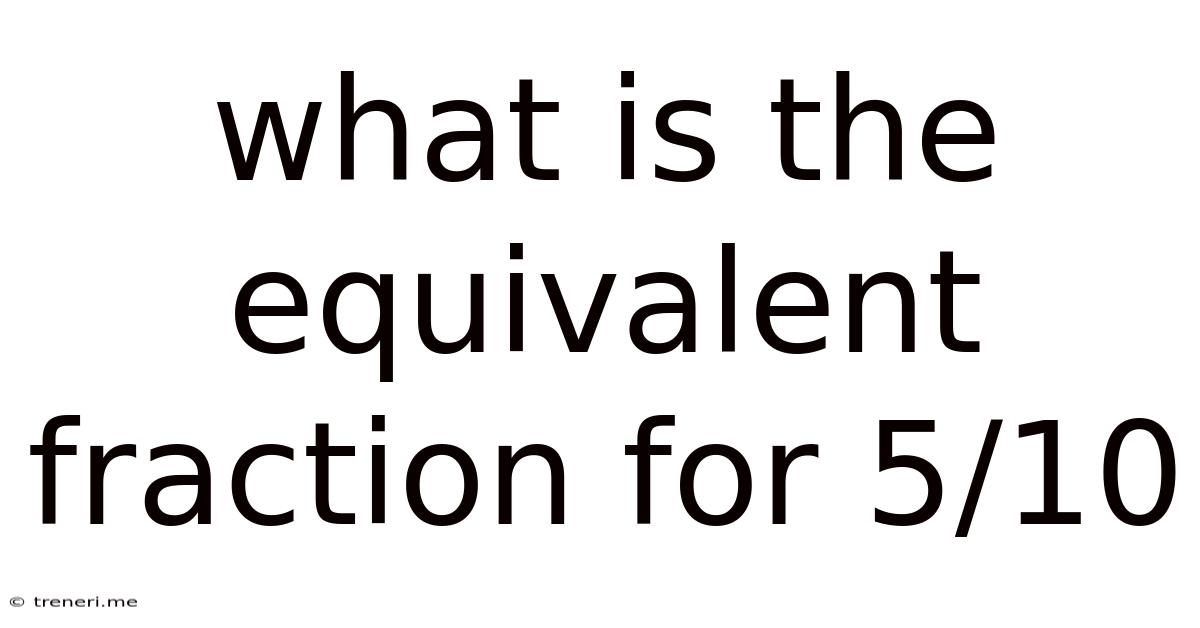What Is The Equivalent Fraction For 5/10
Treneri
May 14, 2025 · 4 min read

Table of Contents
What is the Equivalent Fraction for 5/10? A Deep Dive into Fraction Simplification
Finding equivalent fractions is a fundamental concept in mathematics, crucial for understanding ratios, proportions, and simplifying complex calculations. This comprehensive guide will explore the concept of equivalent fractions, focusing specifically on finding the equivalent fraction for 5/10. We’ll delve into the process of simplification, explore various methods, and provide practical examples to solidify your understanding. By the end, you'll not only know the answer but also grasp the underlying principles and be able to confidently tackle similar problems.
Understanding Equivalent Fractions
Equivalent fractions represent the same portion or value, even though they appear different. Imagine cutting a pizza into 10 slices and taking 5; you've consumed half the pizza. Now, imagine cutting the same pizza into 2 slices and taking 1; you've still consumed half. Both 5/10 and 1/2 represent the same amount, making them equivalent fractions.
The key to understanding equivalent fractions lies in the concept of simplification. We simplify fractions by finding the greatest common divisor (GCD) or greatest common factor (GCF) of the numerator (top number) and the denominator (bottom number) and dividing both by it. This process reduces the fraction to its simplest form, without changing its value.
Finding the Equivalent Fraction for 5/10: A Step-by-Step Approach
Let's tackle the specific problem: finding an equivalent fraction for 5/10.
Step 1: Identify the Numerator and Denominator
Our fraction is 5/10. The numerator is 5, and the denominator is 10.
Step 2: Find the Greatest Common Divisor (GCD)
The GCD is the largest number that divides both the numerator and the denominator without leaving a remainder. For 5 and 10, the GCD is 5. You can find the GCD using various methods:
-
Listing Factors: List the factors of both numbers and find the largest one they share. Factors of 5 are 1 and 5. Factors of 10 are 1, 2, 5, and 10. The largest common factor is 5.
-
Prime Factorization: Break down both numbers into their prime factors. 5 is a prime number (only divisible by 1 and itself). 10 = 2 x 5. The common prime factor is 5.
-
Euclidean Algorithm: This is a more efficient method for larger numbers, but for smaller numbers like these, the first two methods are perfectly adequate.
Step 3: Divide the Numerator and Denominator by the GCD
Divide both the numerator (5) and the denominator (10) by the GCD (5):
- 5 ÷ 5 = 1
- 10 ÷ 5 = 2
Step 4: Write the Simplified Fraction
The simplified fraction is 1/2. Therefore, the equivalent fraction for 5/10 is 1/2.
Visualizing Equivalent Fractions
Visual representations can significantly enhance understanding. Imagine a rectangle divided into 10 equal parts. Shading 5 of these parts represents 5/10. Now, imagine dividing the same rectangle in half. Shading one half represents 1/2. Both shaded areas are identical, visually demonstrating the equivalence.
Other Equivalent Fractions for 5/10
While 1/2 is the simplest form, infinitely many other equivalent fractions exist. You can create them by multiplying both the numerator and denominator by the same number (any whole number greater than 1). For example:
- Multiplying by 2: (5 x 2) / (10 x 2) = 10/20
- Multiplying by 3: (5 x 3) / (10 x 3) = 15/30
- Multiplying by 4: (5 x 4) / (10 x 4) = 20/40
And so on. All these fractions are equivalent to 5/10 and 1/2.
Practical Applications of Equivalent Fractions
Understanding equivalent fractions is vital in numerous real-world scenarios:
-
Cooking: Recipes often require adjusting ingredient amounts. If a recipe calls for 5/10 cup of sugar and you want to halve the recipe, you'll need to know that 5/10 is equivalent to 1/2 cup.
-
Construction: Measuring and cutting materials accurately necessitates working with fractions and their equivalents.
-
Finance: Calculating percentages, interest rates, and proportions all rely on the manipulation of fractions and their simplified forms.
Common Mistakes to Avoid
-
Only dividing the numerator or denominator: Remember, to maintain equivalence, you must divide both the numerator and the denominator by the GCD.
-
Incorrectly identifying the GCD: Double-check your calculations to ensure you've found the largest common divisor.
-
Not simplifying to the lowest terms: While other equivalent fractions are valid, presenting the simplest form (1/2 in this case) is generally preferred for clarity and efficiency.
Beyond 5/10: Mastering Fraction Simplification
The principles discussed here extend to any fraction. To simplify any fraction, follow these steps:
- Find the GCD of the numerator and denominator.
- Divide both the numerator and the denominator by the GCD.
- The resulting fraction is the simplest form.
Conclusion: Equivalence and Simplicity in Fractions
The equivalent fraction for 5/10 is 1/2. Understanding how to find equivalent fractions, particularly by simplifying to the lowest terms, is a fundamental skill in mathematics with far-reaching practical applications. By mastering this concept, you’ll strengthen your mathematical foundation and gain confidence in tackling more complex problems involving ratios, proportions, and other mathematical operations. Remember to practice regularly, visualize the fractions, and always double-check your work for accuracy. Consistent practice will make you proficient in handling fractions and their equivalents with ease.
Latest Posts
Latest Posts
-
How Many Days Are In 90 Years
May 14, 2025
-
36 Inches Equals How Many Yards
May 14, 2025
-
60 Days After November 8 2024
May 14, 2025
-
1 Electron Volt Is Equal To
May 14, 2025
-
How Many Milligrams Is 2 Teaspoons
May 14, 2025
Related Post
Thank you for visiting our website which covers about What Is The Equivalent Fraction For 5/10 . We hope the information provided has been useful to you. Feel free to contact us if you have any questions or need further assistance. See you next time and don't miss to bookmark.